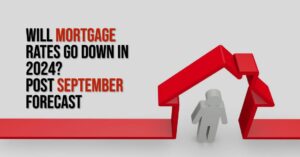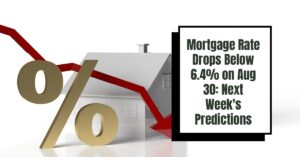As we step into September 2024, the burning question on the minds of both prospective homebuyers and those looking to refinance is: Will mortgage rates go down in 2024? Yes, rates are gradually predicted to go down in the second half of 2024. However, understanding the landscape of mortgage rates can feel overwhelming, especially with fluctuating economic factors, recent inflation data, and Federal Reserve movements influencing the market. Let's find out what experts have to say.
Will Mortgage Rates Go Down in September and the Remainder of 2024?
Key Takeaways:
- Predictions of Declines: Experts anticipate a gradual decline in mortgage rates throughout the remainder of 2024.
- Rates Variation: Predictions suggest average rates might reach the 6.4% mark by September and hover around 6.5-6.6% by the year’s end.
- Influencing Factors: Major influences include the Federal Reserve's interest rate decisions and economic health indicators, particularly inflation and employment rates.
- Refinancing Opportunities: As rates decrease, the potential for significant savings in mortgage payments could emerge for homeowners refinancing their current loans.
Current Market Overview
The backdrop of the current mortgage rate environment is primarily shaped by the Federal Reserve's monetary policies and broader economic indicators. As of now, the average 30-year fixed mortgage rate is significantly above 6%, making home buying less affordable for many potential buyers.
According to a recent forecast by Bankrate, economists expect mortgage rates to experience a slight cooling, potentially reaching 6.4% by mid-to-late September 2024. This decrease is anticipated to be a result of the Fed's decisions during its upcoming meetings and adjustments to current economic conditions. Most experts are cautiously optimistic, believing the overall trend will be relatively gradual, with rates on a slow downward trajectory as we approach the end of the year.
Factors Impacting Mortgage Rates
Several elements play a critical role in the movement of mortgage rates:
- Federal Reserve Policy: The actions of the Federal Reserve (the Fed) are a pivotal influence on mortgage rates. The Fed's decisions regarding interest rates directly affect borrowing costs for financial institutions, which in turn impacts the rates offered to consumers. Currently, there are speculations surrounding an interest rate cut during the Fed's meetings on September 17 and 18, which could positively influence mortgage rates.
- Inflation Trends: Inflation remains a significant factor. High inflation often leads to higher interest rates, but recent trends indicate a potential cooling of inflation. If this pattern continues, it may lead to lower mortgage rates. Data suggests that inflation, after hitting high levels over the past two years, is showing signs of easing.
- Employment Statistics: Employment figures also matter, as a robust job market tends to support consumer spending and borrowing. However, if job growth stalls or unemployment rises, this could pressure the Fed to lower rates to stimulate the economy, further influencing mortgage rates to dip.
Expert Predictions and Insights
The consensus among real estate experts points to a continued trend of declining mortgage rates for the remainder of 2024. For instance, Fannie Mae analysts predict 30-year mortgage rates could settle around 6.4% by the fourth quarter of 2024, while the Mortgage Bankers Association offers similar forecasts, aiming for rates near 6.6%.
This sentiment is echoed by Dr. Lisa Sturtevant, the Chief Economist at a noted real estate advisory, who emphasizes that signs of potential interest rate cuts are visible. She observes, “The recent decline in mortgage rates anticipates the all-but-certain September interest rate cut” (Forbes), which could spark further declines in mortgage rates moving forward.
I find it fascinating how interconnected these economic indicators are. The correlation between job rates, inflation, and mortgage rates is complex yet reveals the intricate web that ties together the broader economy. Understanding this interconnectedness equips potential homebuyers with insights into when to act in the housing market.
Market Sentiment and Future Outlook
Market sentiment going into September is marked by cautious optimism. As mortgage rates show signs of trending downward, potential homebuyers are encouraged to consider their options. The structural changes in the economy, influenced significantly by expected Fed rate cuts, suggest a window of opportunity for refinancing existing mortgages or making new home purchases at more attractive rates.
Looking ahead, if inflation continues to remain stagnant, consumer confidence could stabilize, promoting more robust economic activity in housing. However, volatility remains a hallmark of the current economic environment, and various unpredictable factors could still affect rates in unforeseen ways.
Do mortgage rates go down when the Fed cuts rates?
Yes, mortgage rates often go down when the Federal Reserve cuts its benchmark interest rates, as it typically reduces borrowing costs for lenders. However, the exact change in mortgage rates can vary and doesn't always perfectly correlate to Fed actions.
What will cause mortgage rates to go down?
Mortgage rates may decrease due to several factors, including:
- Federal Reserve interest rate cuts.
- Improvements in inflation rates.
- Economic downturns leading to decreased consumer demand.
- Increased competition among lenders, leading to lower rates offered to consumers.
When in September will interest rates drop?
The most anticipated timing for a drop in interest rates is expected around September 18, 2024, when the Federal Reserve is likely to announce its decision on rate cuts.
Conclusion: The Road Ahead
While the forecast for mortgage rates suggests a downward trend in September and towards the end of 2024, it remains essential to consider the broader economic picture. The interconnectedness of various economic indicators—like Federal Reserve policies, inflation trends, and the job market—creates a complex environment for predicting movements in mortgage rates. The general outlook is promising, but potential buyers should remain informed and vigilant.
ALSO READ:
- Mortgage Interest Rate Predictions After Powell's Jackson Hole Speech
- Will Mortgage Rates Ever Be 3% Again: Future Outlook
- Mortgage Rates Predictions for Next 2 Years
- Mortgage Rate Predictions for Next 5 Years
- Mortgage Rate Predictions for 2025: Expert Forecast
- Prediction: Interest Rates Falling Below 6% Will Explode the Housing Market
- Mortgage Rate Predictions: Why 2% and 3% Rates are Out of Reach
- How Lower Mortgage Rates Can Save You Thousands?
- How to Get a Low Mortgage Interest Rate?
- Will Mortgage Rates Ever Be 4% Again?
- What Will Mortgage Rates Be in 2026: Latest Predictions











